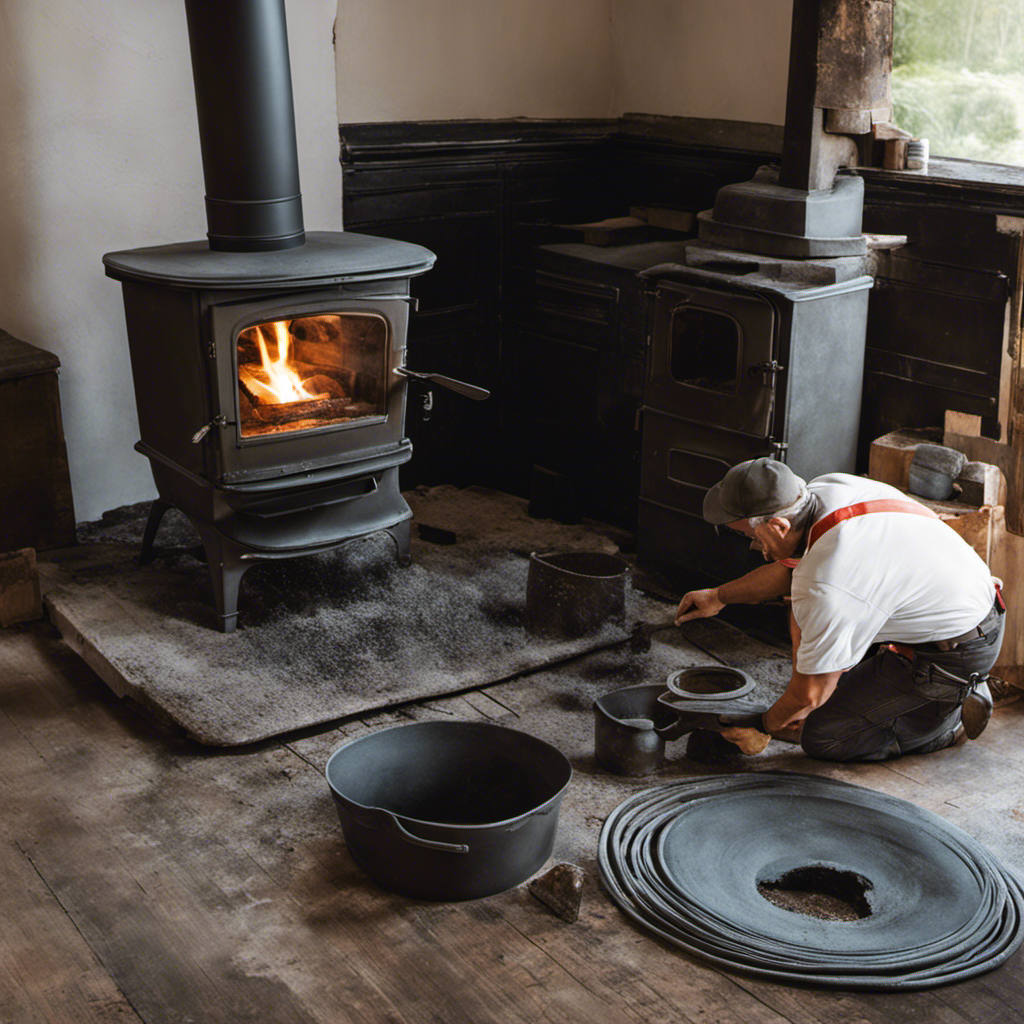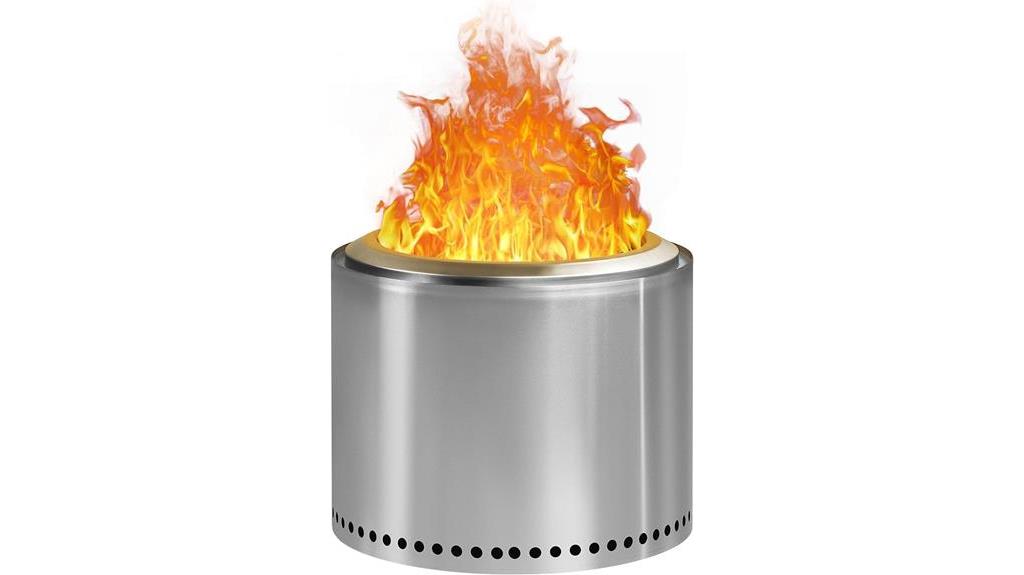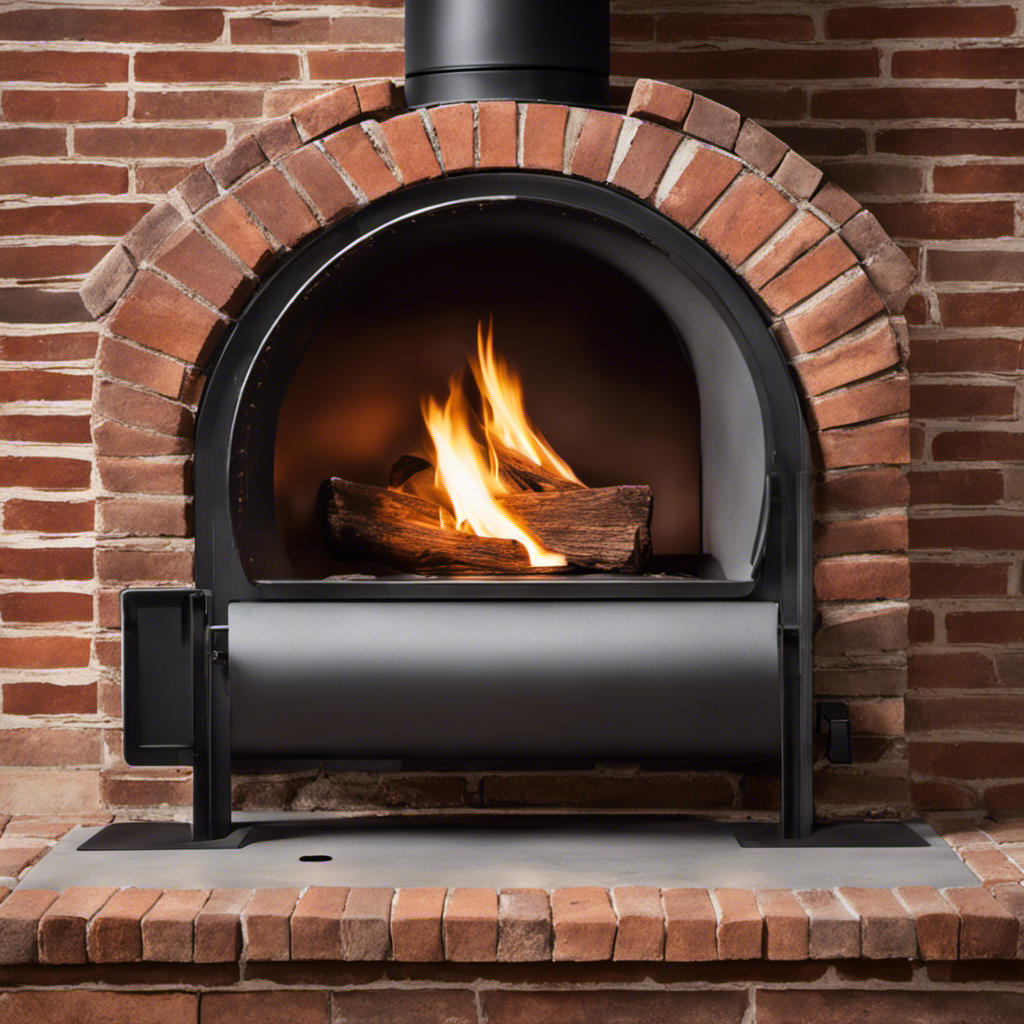I just upgraded the gaskets on my wood stove with stove cement, and now I’m considering how long I should wait before using it. It’s important to allow enough time for it to cure, in order to create a tight seal and avoid potential leaks or damage.
In this article, we’ll explore the factors that affect curing time, the recommended waiting period, and the signs of a fully cured seal. Plus, I’ll share some tips for successful sealing and firing.
Let’s dive in!
Key Takeaways
- Curing time is crucial for proper sealing and prevention of leaks and damage.
- Rushing the curing process can result in premature failure of the gasket.
- It is recommended to wait at least 24 hours before using the wood stove after replacing gaskets with stove cement.
- Regular inspections and cleanings are essential for maintaining wood stoves and ensuring a strong and durable seal.
The Importance of Curing Time
I understand the importance of curing time when it comes to replacing wood stove gaskets with stove cement.
Common mistakes when applying stove cement can lead to improper sealing of the gaskets, resulting in leaks and reduced efficiency.
To properly maintain wood stove gaskets, it’s crucial to ensure a secure bond between the gasket and the stove using stove cement.
After applying the cement, it’s essential to allow sufficient time for it to cure. Curing time refers to the period required for the cement to harden and reach its maximum strength.
Rushing this process can lead to premature failure of the gasket. Factors affecting curing time include temperature, humidity, and the type of cement used.
Understanding and adhering to the recommended curing time is vital for ensuring a durable and effective seal.
Factors Affecting Curing Time
There are several factors that can affect the curing time of stove cement, such as temperature and humidity. When replacing wood stove gaskets with stove cement, it is important to consider these factors to ensure a proper cure. Common mistakes include not allowing enough time for the cement to cure, which can result in leaks and reduced stove efficiency.
In order to help you understand the factors that affect curing time, I have prepared a table below:
| Factors to Consider | Ideal Range | Impact on Curing Time |
|---|---|---|
| Temperature | 70-90°F | Higher temperatures can speed up curing time, while lower temperatures can slow it down. |
| Humidity | 40-60% | High humidity can slow down the curing process, while low humidity can speed it up. |
| Thickness of Cement | Thin | Thicker layers of cement may require more time to cure properly. |
Recommended Waiting Period
To ensure optimal results, it’s recommended to wait at least 24 hours before using the wood stove after applying the stove cement. This waiting period allows the cement to properly cure and ensures a secure and long-lasting bond between the gasket and the stove. Firing the stove too soon can lead to potential risks such as the gasket coming loose or not sealing properly, which can result in heat loss and decreased stove efficiency.
To properly clean and prepare the gasket surface before applying stove cement, follow these steps:
- Remove any remnants of the old gasket using a scraper or wire brush.
- Clean the surface thoroughly with a mild detergent or stove cleaner to remove any dirt, grease, or debris.
- Rinse the surface with water and allow it to dry completely before applying the stove cement.
- Apply a thin, even layer of stove cement to the gasket surface, ensuring full coverage and smooth application.
Signs of a Fully Cured Seal
After waiting the recommended 24 hours, you can determine if the seal is fully cured by checking for both a solid bond and a lack of any visible cracks or gaps.
It’s crucial to wait for the proper curing time to ensure a strong and durable seal on your wood stove. One of the common mistakes when replacing wood stove gaskets isn’t allowing enough time for the seal to fully cure. Rushing the process can result in a weak bond and potential leaks.
To properly maintain and clean wood stoves for optimal performance, regular inspections and cleanings are essential. Remove any ash buildup, clean the glass door, and inspect the gaskets for wear and tear. Regular maintenance won’t only ensure the longevity of your wood stove but also enhance its efficiency and safety.
Tips for Successful Sealing and Firing
I’ve found that using high-quality firebrick can greatly contribute to successful sealing and firing of my wood stove. When properly applied, the firebrick creates a tight seal, preventing any air leaks and maximizing the efficiency of the stove.
Here are some tips for successful sealing and firing:
-
Choose the right firebrick: Look for firebrick with a high refractory rating and low thermal conductivity to ensure its durability and heat retention capabilities.
-
Proper application techniques: Clean the surface thoroughly before applying the firebrick. Use a high-temperature adhesive or cement to secure the firebrick in place. Follow the manufacturer’s instructions for curing time.
-
Avoid common mistakes: Don’t use low-quality firebrick as it may crack or deteriorate quickly. Make sure the firebrick is properly aligned to prevent gaps or uneven surfaces. Avoid over-tightening the bolts, as it may cause damage to the firebrick.
-
Regular maintenance: Check the firebrick regularly for any signs of wear or damage. Replace any cracked or broken firebrick promptly to maintain the stove’s efficiency.
Frequently Asked Questions
Can I Use My Wood Stove Immediately After Replacing the Gaskets With Stove Cement?
I can use my wood stove immediately after replacing the gaskets with stove cement. It’s important for wood stove maintenance to ensure a proper seal, and using stove cement offers numerous benefits.
What Happens if I Don’t Wait the Recommended Waiting Period Before Using My Wood Stove?
If I don’t wait the recommended time after replacing my wood stove gaskets with stove cement, disaster could strike! The importance of proper curing time cannot be overstated for wood stove gasket maintenance.
Can I Speed up the Curing Time of the Stove Cement?
I’m not an expert, but there are alternative methods to potentially speed up the curing time of stove cement. It’s important to follow the manufacturer’s recommendations, but researching and experimenting might provide some options.
How Often Should I Replace the Gaskets in My Wood Stove?
Inspecting wood stove gaskets regularly is crucial for safety. Properly installed gaskets maintain a tight seal, preventing leaks and maximizing efficiency. The frequency of replacement depends on usage and wear, so check them periodically to ensure optimal performance.
Are There Any Safety Precautions I Should Take While the Stove Cement Is Curing?
During the curing process of stove cement, it is important to take safety measures. Rushing to use the wood stove too soon can pose potential risks. It is crucial to wait until the cement has fully cured before using the stove.
Conclusion
In conclusion, waiting for the curing process after replacing wood stove gaskets with stove cement is of utmost importance.
While there are factors that can affect the curing time, it’s recommended to wait for a sufficient period to ensure a fully cured seal.
By following the recommended waiting period and looking out for signs of a fully cured seal, you can ensure successful sealing and firing of your wood stove.
So, be patient and let the magic of curing work its wonders!
Logan’s affair with adventure began in childhood. He hailed from a small town where vast forests bordered one side and endless shores stretched on the other. His days were spent exploring uncharted woods, climbing tall trees, or listening to the tales of old sailors. This early immersion in a world brimming with stories and mysteries became the foundation of his passion for writing.











